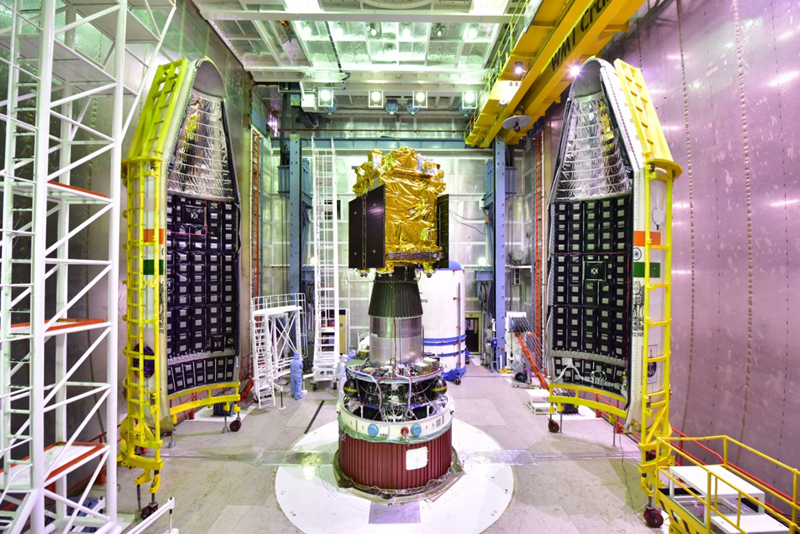 Aditya L1
Aditya L1
ISRO's Aditya-L1 solar mission placed in halo orbit, PM Modi appreciates
Expanding India's space exploration, Aditya-L1, the country's first mission to study the sun, was parked at Lagrange Point 1 on Saturday, Indian Space Research Organisation said.
"Halo-Orbit Insertion (HOI) of its solar observatory spacecraft, Aditya-L1 was accomplished at 16.00 Hrs (approx) on January 6, 2024 (IST). The final phase of the maneuver involved firing of control engines for a short duration," ISRO said in a statement.
The orbit of Aditya-L1 spacecraft is a periodic Halo orbit which is located roughly 1.5 million km from earth on the continuously moving Sun – Earth line with an orbital period of about 177.86 earth days. This Halo orbit is a periodic, three-dimensional orbit at L1 involving Sun, Earth and a spacecraft.
This specific halo orbit is selected to ensure a mission lifetime of 5 years, minimising station-keeping manoeuvres and thus fuel consumption and ensuring a continuous, unobstructed view of the sun.
Indian leaders congratulate
Indian PM Narendra Modi described the moment as a 'landmark'.
India creates yet another landmark. India’s first solar observatory Aditya-L1 reaches it’s destination. It is a testament to the relentless dedication of our scientists in realising among the most complex and intricate space missions. I join the nation in applauding this…
— Narendra Modi (@narendramodi) January 6, 2024
Indian PM Narendra Modi posted on X: "India creates yet another landmark. India’s first solar observatory Aditya-L1 reaches it’s destination. It is a testament to the relentless dedication of our scientists in realising among the most complex and intricate space missions. I join the nation in applauding this extraordinary feat. We will continue to pursue new frontiers of science for the benefit of humanity."
Another grand feat accomplished by ISRO! As part of India’s maiden solar mission, Aditya L1, the observatory has been placed in the final orbit and reached its destination at Lagrange Point 1. Congratulations to the entire Indian scientist community for the great achievement!…
— President of India (@rashtrapatibhvn) January 6, 2024
President Droupadi Murmu wrote on X: "Another grand feat accomplished by ISRO! As part of India’s maiden solar mission, Aditya L1, the observatory has been placed in the final orbit and reached its destination at Lagrange Point 1. Congratulations to the entire Indian scientist community for the great achievement! This mission will enhance our knowledge of the Sun-Earth System and benefit the entire humanity. Significant participation of women scientists in ISRO missions takes women empowerment too onto a higher orbit."
Aditya-L1 Mission
The Aditya-L1 mission is an Indian solar observatory at Lagrangian point L1 for “Observing and understanding the chromospheric and coronal dynamics of the Sun” in a continuous manner.
Placing the Aditya-L1 in a halo orbit around L1 point has advantages as compared to placing in a Low Earth Orbit (LEO)
It provides a smooth Sun-spacecraft velocity change throughout the orbit, appropriate for helioseismology.
It is outside of the magnetosphere of Earth, thus suitable for the "in situ" sampling of the solar wind and particles.
It allows unobstructed, continuous observation of the Sun, and view of earth for enabling continuous communication to ground stations.
Halo orbit insertion
The halo orbit insertion process commenced as the spacecraft crossed the XZ plane in the Sun-Earth- L1 rotating system, with the required orbital state. The insertion maneuver is essential to nullify the X and Z velocity components and attain the required Y-velocity in the L1 rotating frame for the required Halo orbit.
"The targeted Halo-orbit for Aditya-L1 is Ax: 209200 km, Ay : 663200 km and Az : 120000 km," read a statement issued by ISRO.
The insertion of Aditya-L1 into this Halo orbit presents a critical mission phase, which demanded precise navigation and control.
A successful insertion further involved constant monitoring along with the adjustment of the spacecraft's speed and position by using onboard thrusters.
The success of this insertion not only signifies ISRO's capabilities in such complex orbital manoeuvres, but it but gives confidence to handle future interplanetary missions.
Support Our Journalism
We cannot do without you.. your contribution supports unbiased journalism
IBNS is not driven by any ism- not wokeism, not racism, not skewed secularism, not hyper right-wing or left liberal ideals, nor by any hardline religious beliefs or hyper nationalism. We want to serve you good old objective news, as they are. We do not judge or preach. We let people decide for themselves. We only try to present factual and well-sourced news.







